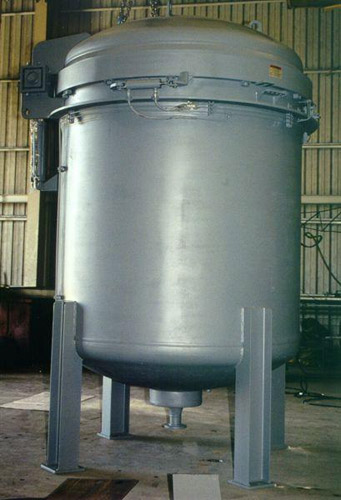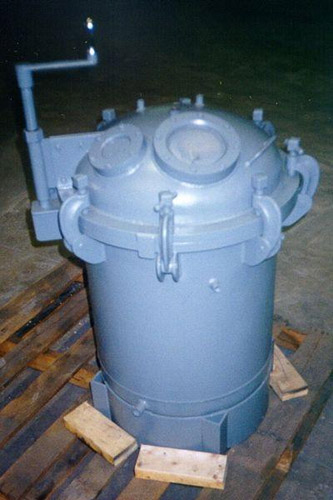



Product
Vacuum Pressure Impregnation (VPI) Autoclaves
At our 25,000 sq. ft. fabrication shop, we perform custom designing, fabricating, testing, and installation of a broad range of vacuum pressure impregnation (VPI) autoclaves. Melco Steel, Inc. impregnating systems are best suited for wood treating, resin impregnating, as well as other processing applications in industries ranging from carbon and wood product manufacturing to metallurgy. Our VPI autoclaves can be used as cost-effective alternatives for conventional dip and bake methods for processing electrical windings, armatures, castings, or powdered metal products.
Depending on your specific processing needs, VPI systems can be offered in vertical/horizontal and vacuum/non-vacuum designs. Auxiliary support systems of our VPI autoclaves include storage racks, internal support racks, cart racks, flooring, and manifolds. The hydraulic cylinders used to swing open the doors of our VPI process vessels are fitted with a counterbalance valve. This device is used to prevent the door from falling in the event of hydraulic system failure.
We specialize in building counterbalance valves customized to your VPI tank configuration and weight. A kit can be provided that consists of a factory set counterbalance valve, tube, and tube fittings for installation on a existing VPI tank fitted with non-counterbalance valve. Depending on the size and type of parts impregnated, desired sealing results, as well as other production parameters, our VPI systems can be customized in a number of ways.
Vacuum Pressure Impregnation (VPI) Autoclaves Specifications
Autoclave Specifications
Equipment Capabilities
Materials
Maximum Working Diameter
Maximum Working Length
Maximum Operating Pressure
Maximum Operating Temperature
Maximum Wall Thickness
Pressurizing Medium
Heating Methods
Autoclave Parts
Standard Features
- Encapsulated blower motor eliminates the high maintenance necessary for through the vessel shaft sealing.
- Proprietary blower motor design allows operation at any combination of pressure and temperature.
- Engineered circulating fan assures excellent heat transfer to the load and exceptional temperature uniformity.
- Proprietary method of placing and securing insulation minimizes heat loss through the pressure vessel and minimizes operating costs.
- Location of typical electrical heating unit is shielded by cooling coil to prevent radiant heating of load.
- Cooling coil is a single pass heat exchanger designed for precise temperature control with ample provisions for thermal expansion to minimize thermally induced stresses and failure.
- “Man-Inside” emergency alarm cables are provided on larger autoclaves which allows operator to completely disable all autoclave sub-systems. It requires autoclave door to be opened to reset the alarm.
- Load track and floor is designed to allow for thermal expansion yet provide full structural support.
- ASME approved safety relief valve and rupture disc are provided on separate vessel penetrations to assure independent and safe operation. Many other redundant safeties are incorporated to assure operator and equipment protection.
- Most vessel penetrations, such as vacuum, thermocouple and cooling are built into removable and replaceable ANSI flanges. This allows easy modification or repairs without compromising the structural integrity of the vessel.
Harris Quick Opening Door Features
- This proprietary breech lock door allows full and easy access to the autoclave interior within one minute after completion of a curing cycle.
- Safety is inherent in its design, but we also include mechanical, hydraulic, electrical, and pneumatic interlocks to prevent door operation while the autoclave is pressurized.
- No relative motion of the door with respect to the pressure seal provides long o-ring life.
- An oxygen sensor/fresh air purge safety interlock is available to prevent opening the door unless safe levels of oxygen are present. This complies with recent OSHA rulings.
Capabilities
Services
Support Services
Instrumentation Options
Control Capabilities
Control Options
Honeywell Computer Controls
Manual Controls
Network Compatible Computer-Based
Control Systems Programmable
Microprocessor-Based Controls Systems
Set Point Controls
